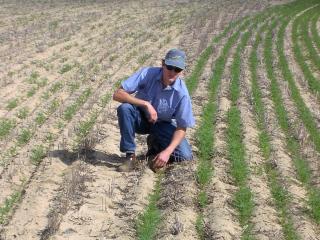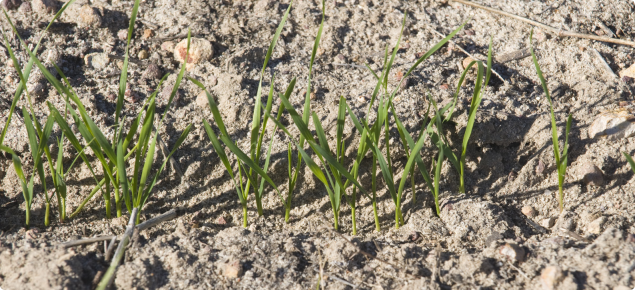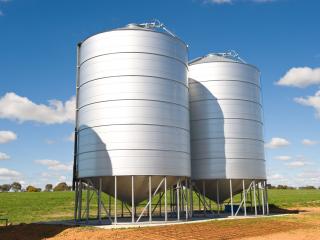Viability of grain for seeding
Seed is a living entity and once it is mature, it will begin to deteriorate. The rate of deterioration depends on;
- the species
- initial quality of the seed
- harvest and handling of the seed
- storage conditions.
Prior to seeding, get your retained seed tested by a seed testing laboratory such as DDLS Seed Testing and Certification or do your own germination test (see this page).
What factors may reduce the viability of your retained seed?
Harvest conditions
Wet seed at harvest
When the grain is subjected to wetting at harvest it will absorb moisture and start the chemical process for germination. Often the seed will swell and the skin covering the growing point will split. This seed is referred to as being sprung. Sprouted (or sprung) grain can occur after prolonged periods of wet weather while they are still on the stem before harvest. If the seed dries out before the embryo starts to grow, the seed could still be viable however the seedling vigour is often reduced. For more information refer to Wheat grain quality - falling number and sprouting tolerance and the Barley production - effect of weather damage on quality and varietal purity.

Sprung seed is more susceptible to fungal attack (can become mouldy and infested with alternarias for example) and more are vulnerable to physical damage.
Weather damaged seed deteriorates at a much faster rate that sound seed and should not be stored for more than one season. The seed needs to be stored in cool dry conditions with adequate pest control.
Due to the small seed size of canola (open-pollinate varieties), it should not be retained for seed if there is any weather damage. Seed should never be retained from hybrid canola. For more information refer to the GRDC factsheet Retaining seed.
Dark fungal staining can occur if there is wet, humid weather during grain maturity. It produces a dark brown, black or grey discolouration on any part of the grain and is often associated with shrivelling.
High harvest temperatures and seed moisture
Harvested seed retains its temperature in storage unless it is cooled. Both air and grain are excellent natural insulators and the temperature that grain is loaded in at, is likely to stay relatively constant until grain is loaded out. Thus if the grain is loading in under high temperature conditions, particularly if there is any moisture in the grain, the viability of grain can be significantly affected reasonably quickly.

There is a relationship between storage temperature and moisture on seed germination and the viability of grain deteriorates faster at higher temperatures and moisture content.
Work by CSIRO Stored Grain Laboratory showed that at 30°C storage temperature and 15% moisture content, the viability of wheat had dropped to below 20% after 120 days compared to only 90% when stored at 12% moisture content. At 20°C, the rate of deterioration declined substantially at both moisture contents; the viability of wheat when stored at 15% moisture content was above 90% after 120 days while the drop in viability of wheat stored at 12% moisture content was negligible.
It is recommended that canola is stored below 7% moisture content. Unlike cereals (which typically contain only about 2% oil by weight), the oil fraction of canola (which can be up to 50%) absorbs minimal moisture, meaning a small increase in moisture content can quickly produce self-heating and seed damage.
For more information refer to the GRDC Stored Grain hub
| Maximum temperaure (°C) | Maximum moisture content (%) | |
|---|---|---|
| Cereals | 20 | 12 |
| Canola | 20 | 7.5 |
| Pulses | 20 | 12.5 |
Grain pests (insects and disease)
Insects
Many grain pests preferentially eat out grain embryos, lowering the percentage of seeds which germinate.
Freshly-harvested cereal grain usually has a temperature around 30°C, which is an ideal breeding temperature for storage pests
| Grain temperature (°C) | Insect/mould development | Grain moisture content (%) |
|---|---|---|
| 40-55 | Seed damage occurs, reducing viability | - |
| 30-40 | Mould and insects prolific | >18 |
| 25-30 | Mould and insects active | 13-18 |
| 20-25 | Mould development is limited | 10-13 |
| 18-20 | Young insects stop developing | 9 |
| <15 | Most insects stop reproducing, mould stops developing | <8 |
For more information refer to Insect pests of stored grain and GRDC factsheets Identification of stored grain pests and Grain storage pest control guide.
Diseases
Fungal diseases affecting grain viability include fusarium head blight and white grain disorder (caused by Tiarosporella spp.) Both of these are quite rare and occur when wet springs promote infection during flowering.
Other factors (contamination with weeds, crop-topping, frost and green grain)
Green wild radish contamination
Contamination is quite common in wheat and lupins, especially in years with late rains when wild radish continues to grow and remains green after crop maturity. This contamination is especially damaging to crop seeds in grain silos because the green wild radish pod gives off substances that actually kill the stored seeds.
The brassica family (to which wild radish belongs) is notorious for the number of volatile toxic substances it produces. The toxins inhibit germination and metabolism, since the affected seeds generally die. Those that emerge result in seedlings with abnormal roots and shoots.
Research into the sensitivity of lupins, field peas, wheat and barley to radish toxins found all four crops to be sensitive. Lupins seem to be the most sensitive and in one experiment, the viability of lupin seed dropped by 20% after just 5 days with 5% contamination with green radish pods (weight by weight).
The higher the contamination level and the longer the storage period, the greater is the damage to the crop seed.
If wild radish is found growing in crops at or near harvest time, avoid harvesting areas of green wild radish if the seed is to be saved for the next year's crop.
In years with late rains, when wild radish continues to grow and remains green after crop maturity, the moisture squeezed from the wild radish stems during harvest often raises the grain moisture content above acceptable storage levels.
Crop-topping and dessication
When the crop is sprayed prior to physiological maturity, grain viability is likely to be reduced. For this reason, glyphosate is not registered for use on seed crops. For more information refer to Crop-topping pulse crops.
Frost-affected grain
Frost affected grains should be graded out prior to seeding. Generally the grains are easily cleaned out when grading as they are lighter in weight.
Green grain – harvested too early
Harvest can theoretically start as soon as the grain moisture falls below about 20% moisture content. Late tillers in cereal crops, can proivide a a source of green sappy grains in early harvested grain samples. There is a lack of information about what happens to green grains during storage or drying and how viable they may be.
Do your own seed germination test
After retaining and storing your crop seed, it is important to know the germination percentage and make sure you have a high proportion of viable seed. While testing seed at a recognised laboratory such as DDLS Seed Testing and Certification may be more accurate, it is easy to do it yourself.
- Collect 100 (or 50) seeds from each lot to be planted.
- Lay four sheets of paper towel on top of each other and moisten (do not drench).
- Place 100 seeds on the paper towels about 10mm apart.
- Roll up, sandwiching the seeds between the moist paper towels.
- Soak a hand towel in water and ring out, then wrap it around the rolled-up paper towel and loosely secure with the rubber bands.
- Place in a plastic bag, seal and place in a warm place (such as the kitchen bench near a window),and leave for 5-7 days.
- Unwrap and count the number of seeds that have not germinated.
- Do your calculation as follows: Germination % = [(number of seeds tested – number of seeds that did not germinate) (multiply by two if you started with 50 seeds).
- Ideally, repeat with a number of samples.






